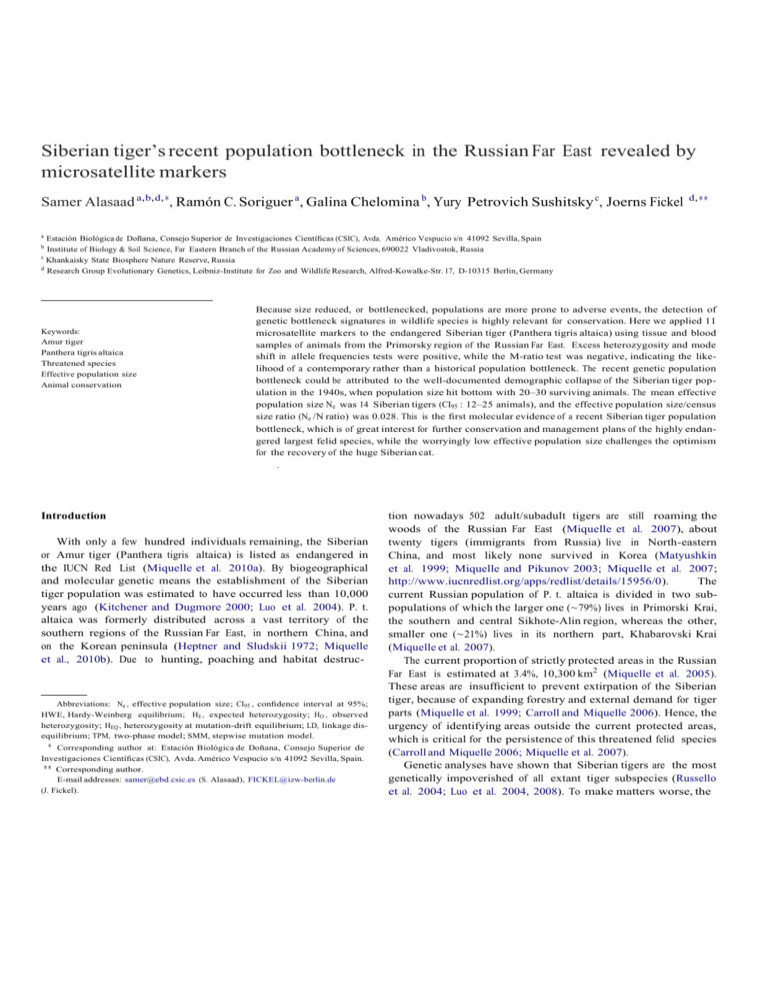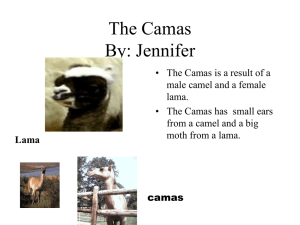Siberian tiger`s recent population bottleneck in the Russian Far East
advertisement

Siberian tiger’s recent population bottleneck in the Russian Far East revealed by microsatellite markers Samer Alasaad a,b,d,∗, Ramón C. Soriguer a, Galina Chelomina b, Yury Petrovich Sushitsky c, Joerns Fickel d,∗∗ a Estación Biológica de Doñana, Consejo Superior de Investigaciones Científicas (CSIC), Avda. Américo Vespucio s/n 41092 Sevilla, Spain Institute of Biology & Soil Science, Far Eastern Branch of the Russian Academy of Sciences, 690022 Vladivostok, Russia Khankaisky State Biosphere Nature Reserve, Russia d Research Group Evolutionary Genetics, Leibniz-Institute for Zoo and Wildlife Research, Alfred-Kowalke-Str. 17, D-10315 Berlin, Germany b c Keywords: Amur tiger Panthera tigris altaica Threatened species Effective population size Animal conservation Because size reduced, or bottlenecked, populations are more prone to adverse events, the detection of genetic bottleneck signatures in wildlife species is highly relevant for conservation. Here we applied 11 microsatellite markers to the endangered Siberian tiger (Panthera tigris altaica) using tissue and blood samples of animals from the Primorsky region of the Russian Far East. Excess heterozygosity and mode shift in allele frequencies tests were positive, while the M-ratio test was negative, indicating the likelihood of a contemporary rather than a historical population bottleneck. The recent genetic population bottleneck could be attributed to the well-documented demographic collapse of the Siberian tiger population in the 1940s, when population size hit bottom with 20–30 surviving animals. The mean effective population size Ne was 14 Siberian tigers (CI95 : 12–25 animals), and the effective population size/census size ratio (Ne /N ratio) was 0.028. This is the first molecular evidence of a recent Siberian tiger population bottleneck, which is of great interest for further conservation and management plans of the highly endangered largest felid species, while the worryingly low effective population size challenges the optimism for the recovery of the huge Siberian cat. . Introduction With only a few hundred individuals remaining, the Siberian or Amur tiger (Panthera tigris altaica) is listed as endangered in the IUCN Red List (Miquelle et al. 2010a). By biogeographical and molecular genetic means the establishment of the Siberian tiger population was estimated to have occurred less than 10,000 years ago (Kitchener and Dugmore 2000; Luo et al. 2004). P. t. altaica was formerly distributed across a vast territory of the southern regions of the Russian Far East, in northern China, and on the Korean peninsula (Heptner and Sludskii 1972; Miquelle et al., 2010b). Due to hunting, poaching and habitat destruc- Abbreviations: Ne , effective population size; CI95 , confidence interval at 95%; HWE, Hardy-Weinberg equilibrium; HE , expected heterozygosity; HO , observed heterozygosity; HEQ , heterozygosity at mutation-drift equilibrium; LD, linkage disequilibrium; TPM, two-phase model; SMM, stepwise mutation model. ∗ Corresponding author at: Estación Biológica de Doñana, Consejo Superior de Investigaciones Científicas (CSIC), Avda. Américo Vespucio s/n 41092 Sevilla, Spain. ∗∗ Corresponding author. E-mail addresses: samer@ebd.csic.es (S. Alasaad), FICKEL@izw-berlin.de (J. Fickel). tion nowadays 502 adult/subadult tigers are still roaming the woods of the Russian Far East (Miquelle et al. 2007), about twenty tigers (immigrants from Russia) live in North-eastern China, and most likely none survived in Korea (Matyushkin et al. 1999; Miquelle and Pikunov 2003; Miquelle et al. 2007; http://www.iucnredlist.org/apps/redlist/details/15956/0). The current Russian population of P. t. altaica is divided in two subpopulations of which the larger one (∼79%) lives in Primorski Krai, the southern and central Sikhote-Alin region, whereas the other, smaller one (∼21%) lives in its northern part, Khabarovski Krai (Miquelle et al. 2007). The current proportion of strictly protected areas in the Russian Far East is estimated at 3.4%, 10,300 km2 (Miquelle et al. 2005). These areas are insufficient to prevent extirpation of the Siberian tiger, because of expanding forestry and external demand for tiger parts (Miquelle et al. 1999; Carroll and Miquelle 2006). Hence, the urgency of identifying areas outside the current protected areas, which is critical for the persistence of this threatened felid species (Carroll and Miquelle 2006; Miquelle et al. 2007). Genetic analyses have shown that Siberian tigers are the most genetically impoverished of all extant tiger subspecies (Russello et al. 2004; Luo et al. 2004, 2008). To make matters worse, the Fig. 1. Map showing approximate sample collection sites in the Russian Far East. ALT is the international abbreviation for Panthera tigris altaica. actual effective population size in the Sikhote-Alin mountain range is estimated to be as low as 28 individuals (CI95 : 19–48) (Henry et al. 2009). Based on the well-documented 20th century decline of the Siberian tiger population, a study was undertaken to find traces of it in the genetic footprint of the species (Henry et al. 2009) by genotyping scat samples across 8 microsatellite loci. However, it failed to find evidence of a recent population bottleneck, although genetic signatures of a historical contraction were detected (Henry et al. 2009). This disparity in signal was argued to be due to several reasons, including historical paucity in population genetic variation associated with postglacial colonization, potential gene flow from a now extirpated Chinese population, and/or potentially insufficient power of the loci used to detect the recent demographic contraction (Henry et al. 2009). The aim of our study was to test for presence and extent of a recent Siberian tiger’s population bottleneck using a larger number of microsatellite loci applied to tissue and blood samples from P. t. altaica belonging to the tiger population of Primorski Krai of the Russian Far East. Material and methods Sample collection and DNA extraction A total of 15 wild-born Siberian tiger individuals were sampled from the distribution range of Primorski Krai of the Russian Far East (Fig. 1) between 1999 and 2000. Blood samples were taken from seven immobilized wild Siberian tigers in time of radio-collaring and were provided for genetic analysis by Russian collaborators of the Russian-Chinese Wildlife Conservation Society (WCS). One tissue sample came from a tiger that had drowned in Khanka Lake and was provided by the Khanka Lake Nature Reserve. Other tissue samples were taken from seven poached animals that had been seized by the staff of the Tiger State Inspection Service of the Russian Far East. The DNA was extracted from blood or tissue samples following the standard phenol/chloroform procedures (Sambrook et al. 1989). The DNA extractions were carried out in a separate laboratory exclusively used for samples expected to have a low DNA concentration. Two blanks (reagents only) were included in each extraction to monitor for contamination (Handt et al. 1994). Fluorescent-based polymerase chain reaction analysis of microsatellite DNA Twenty microsatellite loci (FCA01, FCA06, FCA14, FCA24, FCA69, FCA82, FCA85, FCA96, FCA97, FCA 136, FCA139, FCA161, FCA 191, FCA211, FCA249, FCA261, FCA310, FCA391, FCA441 and FCA719) originally designed for the domestic cat (Felis catus) (MenottiRaymond et al. 2003) were amplified by PCR using fluorescent dye-labelled primers in 6 multiplex reaction (Table 1). PCR was conducted using 1 iil DNA (25–50 ng/iil), 1 iil of each multiplex primer mix (see Table 1 for primer concentrations), 5 iil 2× Multiplex PCR Master Mix and 2 iil 5× Q-solution (both QIAGEN® ) in a final volume of 10 iil. Samples were subjected to the following S Table 1 Characterization of 18 loci for the Siberian tiger (Panthera tigris altaica) based on 15 individuals from the Russian Far East. Panel: PCR multiplex panel. Locus Fluorescent dye Primer concentration (iiM) Panel NA Fragment size (bp) HO HE HEQ FCA14a FCA69 b FCA249a FCA24a FCA85a FCA391b FCA96 b FCA139b FCA719a FCA06a FCA97a FCA136a FCA161b FCA191a FCA211b FCA01a FCA261a FCA310b FAM HEX HEX HEX FAM FAM FAM HEX HEX HEX FAM FAM HEX HEX FAM HEX FAM HEX 0.15 0.15 0.25 0.2 0.1 0.1 0.3 0.1 0.1 0.2 0.2 0.5 0.2 0.3 0.1 0.3 0.1 0.1 I I I II II II III III III IV IV V V V V VI VI VI 4 3 1 2 4 1 2 2 4 2 1 1 3 4 1 2 4 2 152–158 96–102 238 216–218 127–135 210 201–207 132–134 175–187 184–188 140 250 180–188 138–150 109 123–125 196–204 124–206 0.538 0.667 NC 0.533 0.733 NC 0.133 0.357 0.533 0.267 NC NC 0.571 0.400 NC 0.286 0.643 0.286 0.680 0.605 NC 0.515 0.692 NC 0.405 0.516 0.674 0.331 NC NC 0.579 0.646 NC 0.349 0.685 0.349 0.596 0.458 NC 0.285 0.577 NC 0.272 0.275 0.590 0.267 NC NC 0.456 0.466 NC 0.281 0.591 0.275 TPM PHWE 0.111 0.844 NC 1.000 0.800 NC 0.020c 0.314 0.549 0.458 NC NC 0.664 0.020c NC 0.485 0.617 0.492 NA , number of alleles. HO , observed heterozygosity. HE , expected heterozygosity. HEQ , HE under mutation-drift equilibrium for TPM mutation models. NC, not calculated. PHWE , P-value for Hardy-Weinberg equilibrium. a b c Loci tested for cross-species amplification in this study. Loci tested for cross-species amplification by Luo et al. (2004). Locus deviated from HWE. thermal profile for amplification in a CFX96 thermal cycler (BioRad): 15 min at 95 ◦ C (initial denaturing), followed by 35 cycles of three steps of 30 s at 94 ◦ C (denaturation), 30 s at 55 ◦ C (annealing) and 30 s at 72 ◦ C (extension), before a final elongation of 30 min at 60 ◦ C. PCR blanks (reagents only) were included in each PCR experiment. PCR products were sized together with ROX® size standard on an ABI 3130xl Genetic Analyzer (Applied Biosystems). Allele sizes were determined using GeneMapper 3.7 (Applied Biosystems) followed by manual proofreading. To avoid genotyping errors, all PCRs and sample analyses were repeated 3 times. Microsatellite analysis To calculate the expected (HE ) and observed (HO ) heterozygosity, to test for linkage disequilibria (LD), and to test for Hardy-Weinberg equilibrium (HWE) we applied the program Genepop (v.3.4; Raymond and Rousset 1995). Deviations from HWE and tests for LD were evaluated using Fisher’s exact tests and sequential Bonferroni corrections. Detection of possible genotyping mistakes (scoring error due to stuttering, large allele dropout) were made with the software MicroChecker (Oosterhout et al. 2004). To avoid biasing of results by Null-alleles, their frequencies were estimated using ML-NullFreq (Kalinowski and Taper 2006). Theory predicts that in recently bottlenecked populations, observed heterozygosity will be higher than would be expected at mutation-drift equilibrium (HEQ ) (Piry et al. 1999). Therefore we assessed the genetic signature of Siberian tigers using (i) tests to determine heterozygote excess such as sign test, standardized differences test and Wilcoxon sign-rank test, and (ii) the mode-shift test, i.e. distortion of the typical L-shape distribution (all implemented in the software package Bottleneck; v.1.2.02; Piry et al. 1999). Significance was assessed by 10,000 iterations in a one-tailed Wilcoxon sign rank tests. We used the intermediate, two-phase mutation model (TPM) with a proportion of the stepwise mutation model (SMM) of 5% as recommended (Piry et al. 1999). TPM had been shown to deliver the most realistic results of mutational events in microsatellite loci (Di Rienzo et al. 1994). We also calculated the M statistics of Garza and Williamson (2001) (http://swfsc.noaa.gov/textblock.aspx? Division=FED&id=3298), where M here is defined as the ratio of number of alleles k, to their range in size r, applying parameter values from the two-phase model (TPM) specified by the authors (O[4Ne ,u] = 1–10, ps = 0.9, Ag = 3.5) using the program M P Val (Garza and Williamson 2001). During a bottleneck rare alleles are lost quickly by genetic drift thus reducing the number of observed alleles k faster than the size range r of those alleles (r is only reduced by the loss of the largest or the smallest allele), thus resulting in a reduced M-ratio (M = k/r). Critical M values were determined by applying the program Critical M (http://swfsc.noaa.gov/textblock.aspx?Division=FED&id=3298) based on 1000 simulations and additional parameters as implemented by Henry et al. (2009): marker mutation rate ,u = 5 × 10−4 , and pre-bottleneck Ne ranging from 500 to 5000. The M-test is particularly suited to detect historical bottlenecks (Garza and Williamson 2001). To check for possible sub-population structure among the collected samples we used the Bayesian assignment test of the software Structure (v.2.3.3; Pritchard et al. 2000). To determine the appropriate burn-in and run lengths for accurate parameter estimates of P and Q, we set K = 1 and watched for the likelihoods to converge under various burn-in and run lengths. The final burnin and run lengths of Markov chains were then both 105 . We ran 20 independent runs for each K (for K = 1–10) and its associated parameter set to verify the consistency of estimates across runs. Siberian tiger effective population size (Ne ) was estimated based upon the use of summary statistics in an approximate Bayesian computation framework (Tallmon et al. 2004), using the software OneSamp (Tallmon et al. 2008). As priors we considered Ne values ranging between 2 and 500 (Henry et al. 2009). All input file preparations were made using Convert (v. 1.31; Glaubitz 2004). Results and discussion Most populations fluctuate in size and range over time. If the fluctuations are pronounced enough, populations may become very small, experiencing a so-called bottleneck or they may become extinct (Morris and Doak 2002). Although we had only a limited number and scope of samples, our tiger samples at least yielded high-quality DNA from wild individuals, which was not available in previous studies. In our study, we originally used 20 cat (Felis Table 2 Parameters and results for M-ratio and bottleneck analyses used to detect significant reductions in effective population size of Siberian tiger population from the Russian Far East. Bottleneck tests M-ratio test TPM mutation model Sign test Standardized differences test Wilcoxon’s signed rank test Exp = 5.93 Obs = 11 P = 0.001 T2 = 2.744 P = 0.003 P < 0.001 M Mc (O = 1) Mc (O = 2) Mc (O = 10) 0.835 0.492 0.434 0.398 catus; FCA) microsatellite loci. Out of these 18 yielded PCR signals in the Siberian tiger and 13 where polymorphic. FCA82 and FCA441 failed to be amplified. FCA01, FCA06, FCA14, FCA24, FCA82, FCA85, FCA97, FCA136, FCA191, FCA249, FCA261, and FCA719 were cross-species amplified for the first time in the Siberian tiger, while the other 8 loci (FCA69, FCA96, FCA139, FCA161, FCA211, FCA310, FCA391, and FCA441) had been tested previously (Luo et al. 2004). The mean number of alleles per locus was NA = 2.92, ranging from 2 to 4 (Table 1). Loci FCA96 and FCA191 deviated from HWE and were excluded from the analyses, which were based on the remaining eleven loci. For the 11 loci examined there was neither evidence of LD (P > 0.05), nor was there evidence for scoring errors due to stuttering, large allele dropout, or null alleles. The high quality of the DNA extracted from Siberian tiger tissue samples permitted the correct microsatellite scoring without significant error rates. Besides a low mutation rate, the low number of alleles per locus could also be the first indicator of a chronic bottleneck that lasted over multiple generations (Garza and Williamson 2001). It is consistent with earlier analyses considering P. t. altaica the most genetically impoverished of all extant tiger subspecies (Luo et al. 2004, 2008; Russello et al. 2004; Piry et al. 1999). Bottleneck analyses rely, substantially, on the absence of population structure (Busch et al. 2007; Broquet et al. 2010). Population structure and sampling scheme could present a false signal of population bottleneck (Wakeley 1999; Chikhi et al. 2010). Using Bayesian assignment test of the software Structure, ln Pr(X|K) for the likely number of populations K, decreased with increasing K. The mean ln Pr(X|K) values and their standard deviations for the first five K based on 20 iterations were −342.92 ± 0.22 (for K = 1), −344.43 ± 0.74 (K = 2), −344.09 ± 0.65 (K = 3), −346.48 ± 1.24 (K = 4), and −345.32 ± 1.60 (K = 5). As ln Pr(X|K) was highest for K = 1, it indicated that no evidence of sub-structuring exists among the collected samples. We estimated the mean effective population size Ne to be 14 animals (CI95 : 12–25) Considering an upper bound estimate of the Russian Far East tiger population of 502 individuals (Miquelle et al. 2007; Henry et al. 2009), the effective population size/census size ratio (Ne /N ratio) was 0.028, which is about half of the 0.054 obtained by Henry et al. (2009). In comparison with other threatened animals (Palstra and Ruzzante 2008) Ne in Siberian tigers is extremely low, challenging the optimism that the population of the huge cat is in recovery. The mean expected heterozygosity of our data set was HE = 0.540 (Table 1), but our data displayed an excess of heterozygosity relative to the number of alleles expected at mutation–drift equilibrium (HEQ ). Using Bottleneck we detected a significant heterozygosity excess (P < 0.01 for Sign test, standardized differences test, and Wilcoxon’s signed rank tests), indicating a contemporary population bottleneck (Table 2). A bar plot, displaying allele categories (X-axis) versus percentages of alleles in each category (Y-axis) showed a shifted mode for allele frequency distribution (Fig. 2), also indicating a contemporary population bottleneck. Populations with historically relatively stable population sizes will generate L- Fig. 2. Shifted distribution mode of allele frequencies at 11 polymorphic microsatellite loci applied to the Siberian tiger population from the Russian Far East. shaped graphs in such category plots (Piry et al. 1999; Cristescu et al. 2010), while bottlenecks cause alleles at low frequencies (<0.1) to become less abundant than alleles in one or more intermediate allele frequency classes (Luikart et al. 1998), thereby generating the shifted mode for allele frequency distribution observed in the Siberian tiger. The M-ratio which tests for a historical population bottleneck was consistently above the critical value thresholds (Table 2), regardless of the assumed pre-bottleneck Ne . It was also above the critical value of 0.68 proposed by Garza and Williamson (2001). All test results indicate a recent rather than a historical Siberian tiger population bottleneck (Williamson-Natesan 2005). The three different tests for significance used in our study provided statistical evidence of population decline and recovery in two different time scales (recent and historical). While heterozygosity excess and allele frequency distributions recover relatively quickly, the M-ratio is expected to have a long recovery time (Garza and Williamson 2001; Williamson-Natesan 2005). The results did not change significantly when we included the two loci at which allele frequencies deviated from HWE (data not shown). A historical bottleneck had already been detected previously (Henry et al. 2009), likely linked to founder effect of the post-ice age colonization of the tiger’s far eastern distribution range just about 10,000 years ago. This renders Siberian tigers very young compared to other large cats (Luo et al. 2004; Wilting et al., 2010). The study (Henry et al. 2009) however, did not detect a more recent population size contraction, possibly due to the very high rate of missing data across individuals and loci (53–63%). To our knowledge, our results are the first to demonstrate a quite recent genetic bottleneck in Siberian tigers, a result that matches the well-documented severe demographic decline of the Siberian tiger population in the 1940s (Kaplanov 1948). We do not believe this to be coincidence because mode shift and heterozygosity excess are transitory phenomena that become erased over approximately 0.2–4 Ne generations (Luikart and Cornuet 1998). Our results likewise underline the cautious approach researchers and conservationists should take when studying the unknown past of populations by means of microsatellite allele distribution analyses (Cristescu et al. 2010). The findings presented in our study should be taken into account in future molecular studies of this population, because recently bottlenecked populations may have lost lineages that affect inferences of their demographic history from contemporary molecular data sets (Johnson et al. 2007). The molecular bottleneck pattern presented in our study is of pivotal interest, because optimal Siberian tiger management and conservation programs require additional interventions such as S establishing corridors and buffer zones and/or implementing reintroduction programs (Tilson et al. 2001), which in turn require knowledge regarding the genetic background of the individuals included in such measures. Acknowledgements This work was supported by the International Fund for Tiger Save “Phoenix” (Russia), as a part of the “Genetic Investigation of Rare Species Diversity of the Russian Far East project”. We would like to thank Russian-Chinese Wildlife Conservation Society (WCS), Khanka Lake Nature Reserve (Russia), and Tiger State Inspection Service of the Russian Far East (Russia) for providing Siberian tiger samples. We also thank the Spanish Ministerio de Ciencia y Tecnología (Spain). The experiments comply with the current laws of the countries in which the experiments were performed. References Broquet, T., Angelone, S., Jaquiery, J., Joly, P., Léna, J.P., Lengagne, T., Plénet, S., Luquet, E., Perrin, N., 2010. Genetic bottlenecks driven by population disconnection. Conservation Biology 24, 1596–1605. Busch, J.D, Waser, P.M., DeWoody, J.A., 2007. Recent demographic bottlenecks are not accompanied by a genetic signature in banner-tailed kangaroo rats (Dipodomys spectabilis). Molecular Ecology 16, 2450–2462. Carroll, C., Miquelle, D.G., 2006. Spatial viability analysis of Amur tiger Panthera tigris altaica in the Russian Far East: the role of protected areas and landscape matrix in population persistence. Journal of Applied Ecology 43, 1056–1068. Chikhi, L., Sousa, V.C., Luisi, P., Goossens, B., Beaumont, M.A., 2010. The confounding effects of population structure, genetic diversity and the sampling scheme on the detection and quantification of population size changes. Genetics 186, 983–995. Cristescu, R., Sherwin, W.B., Handasyde, K., Cahill, V., Cooper, D.W., 2010. Detecting bottlenecks using BOTTLENECK 1.2.02 in wild populations: the importance of the microsatellite structure. Conservation Genetics 11, 1043–1049. Di Rienzo, A., Peterson, A.C., Garza, J.C., Valdes, A.M., Slatkin, M., Freimer, N.B., 1994. Mutational processes of simple-sequence repeat loci in human populations. Proceedings of the National Academy of Sciences 91, 3166–3170. Garza, J.C., Williamson, E.G., 2001. Detection of reduction in population size using data from microsatellite loci. Molecular Ecology 10, 305–318. Glaubitz, J.C., 2004. CONVERT: a user-friendly program to reformat diploid genotypic data for commonly used population genetic software packages. Molecular Ecology Notes 4, 309–310. Handt, O., Höss, M., Krings, M., Pääbo, S., 1994. Ancient DNA-methodological challenges. Experientia 50, 524–529. Henry, P., Miquelle, D., Sugimoto, T., Mccullough, D.R., Caccone, A., 2009. In situ population structure and ex situ representation of the endangered Amur tiger. Molecular Ecology 18, 3173–3184. Heptner, V.G., Sludskii, A.A., 1972. Carnivora (hyaenas and cats). In: Heptner, V.G., Naumov, N.P. (Eds.), Mammals of the Soviet Union. Amerind Publishing Co., New Delhi, India, pp. 95–193. Johnson, J.A., Dunn, P.O., Bouzat, J.L., 2007. Effects of recent population bottlenecks on reconstructing the demographic history of prairie-chickens. Molecular Ecology 16, 2203–22022. Kalinowski, S.T., Taper, M.L., 2006. Maximum likelihood estimation of the frequency of null alleles at microsatellite loci. Conservation Genetics 7, 991–995. Kaplanov, L.G., 1948. Tigers in Sikhote-Alin. In: Tiger, Red Deer, and Moose, Materialy k poznaniyu fauny i flory SSSR , Novaya Seria, Moscow. Izd. Mosk. Obschestva Ispytateley Prirody, pp. 18–49. Kitchener, A.C., Dugmore, A.J., 2000. Biogeographical change in the tiger, Panthera tigris. Animal Conservation 3, 113–124. Luikart, G., Allendorf, F.W., JCornuet, J.M., Sherwin, W.B., 1998. Distortion of allele frequency distributions provides a test for recent population bottlenecks. Heredity 89, 238–2247. Luikart, G., Cornuet, J.M., 1998. Empirical evaluation of a test for identifying recently bottlenecked populations from allele frequency data. Conservation Biology 12, 228–237. Luo, S.J., Kim, J.H., Johnson, W.E., van der Walt, J., Martenson, J., Yuhki, N., Miquelle, D.G., Uphyrkina, O., Goodrich, J.M., Quigley, H.B., Tilson, R., Brady, G., Martelli, P., Subramaniam, V., McDougal, C., Hean, S., Huang, S.Q., Pan, W., Karanth, K., Sunquist, M., Smith, J.L.D., O’Brien, S.J., 2004. Phylogeography and genetic ancestry of tigers (Panthera tigris). PLoS Biology 2 (12), e442. Luo, S.J., Johnson, W.E., Martenson, Antunes, A., Martelli, P., Uphyrkina, O., TraylorHolzer, K., Smith, J.L.D., O’Brien, S.J., 2008. Subspecies genetic assignments of worldwide captive tigers increase conservation value of captive populations. Current Biology 18, 592–596. Matyushkin, E.N., Pikunov, D.G., Dunishenko, Y.M., Miquelle, D.G., Nikolaev, I.G., Smirnov, E.N., Salkina, G.P., Abramov, V.K., Bazilnikov, B.I., Yudin, V.G., Korkiskho, V.G., 1999. Distribution and numbers of Amur tigers in the Russian Far East in the mid-1990s. In: Aristova, A.A. (Ed.), Rare mammal species of Russia and neighboring territories (in Russian). Russian Academy of Sciences Therological Society, Moscow, pp. 242–271. Menotti-Raymond, M., David, V.A., Chen, Z.Q., Menotti, K.A., Sun, S., Sun, S., Schäffer, A.A., Agarwala, R., Tomlin, J.F., O’brien, S.J., Murphy, W.J., 2003. Secondgeneration integrated genetic linkage/radiation hybrid maps of the domestic cat (Felis catus). Journal of Heredity 94, 95–106. Miquelle, D.G., Merrill, T., Dunishenko, Y.M., Smirnov, E.N., Quigley, H.B., Pikunov, D.G., Hornocker, M.G., 1999. A habitat protection plan for the Amur tiger: developing political and ecological criteria for a viable land-use plan. In: Seidensticker, J., Christie, S., Jackson, P. (Eds.), Riding the Tiger; Meeting the Needs of People and Wildlife in Asia. Cambridge University Press, Cambridge UK, pp. 273–295. Miquelle, D.G., Smirnov, E.N., Salkina, G.A., Abramov, V.K., 2005. The importance of protected areas in Amur tiger conservation: a comparison of tiger and prey abundance in protected areas versus unprotected areas. Results of protection and research of the Sikhote-Alin natural landscape. In: Potikha, I.V., Miquelle, D.G., Gromyko, M.N., Pimenova, E.A., Khobtoneva, L.P., Yu Zaumyslova, O., Labetskaya, N.E., Ivanova, L.V. (Eds.), Papers Presented at the International Science and Management Conference Devoted to the 70th Anniversary of the Sikhote-Alin State Reserve. Terney, Primorksiy Region, September 20–23, 2005. Primpoligraphkombinat, Vladivostok, Russia, pp. 70–74 (in Russian with English abstract). Miquelle, D., Darman, Y., Seryodkin, I., 2010a. Panthera tigris spp. altaica. In: IUCN 2010. IUCN Red List of Threatened Species. Version 2010.4., http://www.iucnredlist.org. Miquelle, D.G., Goodrich, J.M., Smirnov, E.N., Stephens, P.A., Zaumyslova, O.Yu., Chapron, G., Kerley, L., Murzin, A.A., Hornocker, M.G., Quigley, H.B., 2010b. The Amur Tiger: a case study of living on the edge. In: Macdonald, D.W., Loveridge, A. (Eds.), Biology and Conservation of Wild Felids. Oxford University Press, Oxford, UK, pp. 325–339. Miquelle, D.G., Pikunov, D.G., 2003. Status of the Amur tiger and Far Eastern leopard. In: Newell, J.P. (Ed.), The Russian Far East: A Reference Guide for Conservation and Development. Daniel and Daniel Publishers, McKinleyville, California, pp. 106–109. Miquelle, D.G., Pikunov, D.G., Dunishenko, Y.M., Aramilev, V.V., Nikolaev, I.G., Abramov, V.K., Smirnov, E.N., Salkina, G.P., Seryodkin, I.V., Gaponov, V.V., Fomenko, P.V., Litvinov, M.N., Kostyria, A.V., Yudin, V.G., Korkishko, V.G., Murzin AA, 2007. 2005 Amur Tiger Census. Cat News 46, 14–16. Morris, W.F., Doak, D.F., 2002. Quantitative Conservation Biology. Theory and Practice of Population Viability Analysis. Sinauer Associates, Sunderland. Oosterhout, C., Hutchinson, W.F., Wills, D.P.M., Shipley, P., 2004. MICRO-CHECKER: software for identifying and correcting geno-typing errors in microsatellite data. Molecular Ecology Notes 4, 535–538. Palstra, F.P., Ruzzante, D.E., 2008. Genetic estimates of contemporary effective population size: what can they tell us about the importance of genetic stochasticity for wild population persistence? Molecular Ecology 17, 3428–3447. Piry, S., Luikart, G., Cornuet, J.M., 1999. Bottleneck: a computer program for detecting recent reductions in the effective population size using allele frequency data. Journal of Heredity 90, 502–503. Pritchard, J.K., Stephens, M., Donnelly, P., 2000. Inference of population structure using multilocus genotype data. Genetics 155, 945–959. Raymond, M., Rousset, F., 1995. GENEPOP version 1.2: a population genetics software for exact test and ecumenicism. Journal of Heredity 86, 248–249. Russello, M., Gladyshev, E., Miquelle, D., Caccone, A., 2004. Potential genetic consequences of a recent bottleneck in the Amur Tiger of the Russian Far East. Conservation Genetics 5, 707–713. Sambrook, J., Fritsch, E.F., Maniatis, T, 1989. Molecular Cloning: a Laboratory Manual, 2nd ed. Cold Spring Harbor Laboratory, Cold Spring Harbor, NY. Tallmon, D.A., Beaumont, M.A., Luikart, G.H., 2004. Effective population size estimation using approximate Bayesian computation. Genetics 167, 977–988. Tallmon, D.A., Koyuk, A., Luikart, G.H., Beaumont, M.A., 2008. ONESAMP: a program to estimate effective population size using approximate Bayesian computation. Molecular Ecology Resources 8, 299–301. Tilson, R., Nyhus, P., Franklin, F., 2001. Tiger restoration in Asia: ecological reality and sociological reality. In: Maher, D., Noss, R., Larkin, J. (Eds.), Large Mammal Restoration: Ecological and sociological challenges in the 21st Century. Island Press. Wakeley, J., 1999. Nonequilibrium migration in human history. Genetics 153, 1863–1871. Williamson-Natesan, E.G., 2005. Comparison of methods for detecting bottlenecks from microsatellite loci. Conservation Genetics 6, 551–562. Wilting, A., Christiansen, P., Kitchener, A.C., Kemp, Y.J.M., Ambu, L., Fickel, J., 2010. Geo- graphical variation in and evolutionary history of the Sunda clouded leopard (Neofelis diardi) (Mammalia: Carnivora: Felidae) with the description of a new subspecies from Borneo. Molecular Phylogenetics and Evolution, doi:10.1016/j. ympev. 2010. 11.007.






